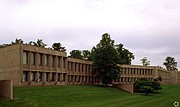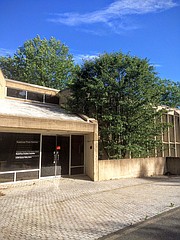The front entrance of the API building features an honor board to those 725 newspapers, newspaper groups, foundations and associations that had contributed to the first API building fund. API Photo
Developer John Sekas told members of the Planning Commission they were about to cut off his neck.
“I stuck my neck way out on the limb on this application because the owner wanted to take the building down before we filed the application. And if this process goes any further, my neck is getting cut off,” said Sekas. A developer of thirty years in the County said he is at risk “because I did the right thing,”
Sekas and the owner applied to the county to propose to demolish the 48,200-square-foot former American Press Institute building to construct 34 single family attached dwellings and one multifamily residential building with 10 units, according to Planning Commission documents.
Planning staff had recommended approval at the vote to be taken on June 16.
“I told the owner not to take the building down. Period,” Sekas said. “The only reason why we were deferred was because of the small stormwater issue. There are no citizens [in opposition] outside of the Architectural Review Board. I mean, I’ve been in rezonings where the line goes up the staircase with opposition from neighbors. We’ve gotten calls from the neighbors who want this project.”
Eleventh-hour advocacy resulted in a much greater understanding of the American Press Institute building and architectural and historical relevance.
The building was designed by architect Marcel Breuer, called a "Master of Modernism," who also designed the Whitney Museum (now the Met Breuer-Metropolitan Museum of Art) and the UNESCO Headquarters in Paris.
Hundreds of people around the globe signed online petitions, wrote the Commission, and rallied to save the building.
“Especially as I look at the petitions, I see that there are many long-time personal friends, acquaintances and neighbors who are those that oppose this application because of its impact on the API building,” said Hunter Mill Planning Commissioner Frank de la Fe. He called his recommendation to approve the rezoning application “one of the most difficult ones that I have had to make in the many years that I have been on the Planning Commission.”
But he and his colleagues on the commission have a responsibility to analyze the facts based on what is presented to them. There was no discussion of preserving the API building, he said.
“During the multi-year review of the Reston Corridor Area leading to the adoption of the current Comprehensive Plan that now governs this area, the – there was no mention of the API building. This multi-year effort included participation by several hundred people, including numerous architects. Again, the API building did not come up and there is nothing in the Comprehensive Plan about it,” he said. “I understand the intensity and the desire to preserve the building but, as I’ve stated before, we must make our recommendation to the Board on the basis of the Comprehensive Plan, applicable codes, rules and regulations as they exist now, not as what may or may not happen in the future.”
Planning staff had recommended approval at the vote to be taken on June 16. Five members of the Commission voted for the application, five voted against it.
The Commission, with its deadlocked vote, sends the application to the Board of Supervisors with a recommendation against approval.
“We’ve received a lot of information about this building, its importance, its significance, the people who came to meetings and participated in conferences at that building, and why it has a real special meaning,” said Dranesville Planning Commissioner John Ulfelder, who voted against the application.
When asked if he would grant county staff additional access to the building, Sekas testified that it was not his decision, it was the owner’s.
“I cannot tell you whether I can give you access or not because we might pull the application and start all over again,” Sekas said.
World-class Building ‘Lost in Communication’
At-large Planning Commissioner James Hart said “we are on the horns of a dilemma.”
The vacant American Press Institute Building at 11690 Sunrise Valley Drive drew international attention before a rezoning hearing at the Fairfax County Planning Commission on June 16, 2016.
The building was designed by architect Marcel Breuer, called a "Master of Modernism," who also designed the Whitney Museum (now the Met Breuer-Metropolitan Museum of Art) and the UNESCO Headquarters in Paris.
“And on this one it’s particularly difficult because we messed up, we – collectively the County, that this structure should have been identified at some point along the way and it wasn’t,” said Hart.
“How did we get to a situation where because of a technicality an architecturally significant building by one of the most significant architects of the 20th century, the only building by him in Virginia, is not protected in any way?” he said.
Sekas Homes and the owner of the property applied to the county to propose to demolish the 48,200-square-foot former American Press Institute building to construct 34 single family attached dwellings and one multifamily residential building with 10 units, according to Planning Commission documents.
Planning staff had recommended approval at the vote to be taken on June 16.
Architects, historians, preservationists, journalists, community leaders and other news media executives who attended API seminars during its Reston years along with API staff members joined the movement to save the American Press Institute building, said Carol Ann Riordan, former executive director of the American Press Institute.
“Just in 48 hours, this has gotten the attention of people all over the globe,” she said. “We would be ecstatic if this world class building could find a second life. Wouldn’t it be marvelous if another organization would move into that grand building and the torch could be passed?”
Planning Commissioners were attentive; six went on a tour of the building in the days before the hearing.
“We’ve received a lot of information about this building, it’s importance, it’s significance, the people who came to meetings and participated in conferences at that building, and why it has a real special meaning,” said Dranesville Commissioner John Ulfelder.
“I think that the County failure to recognize this building’s importance does not really detract from the building’s significance and importance. And I think that we should take a little bit more time,” said Ulfelder, who voted against the application.
Commissioner Hart agreed that “omission of the building from any identification or text in the Comprehensive Plan in no way diminishes its significance.”
“I hope this is a wakeup call to us...,” he said, “we need to make sure that something like this never happens again.”
The Commission, with its deadlocked vote, sends the application to the Board of Supervisors with a recommendation against approval.
Said Braddock Commissioner Ellen Hurley: “The Planning Commission is not a rubber stamp and we do sometimes catch and try to correct previous oversights and omissions. I cannot vote to recommend approval of this project until the building has undergone a determination of eligibility for the National Register of Historic Places, and I will also vote that – against the motion this evening.”
“We have a duty to consider the information that we’ve received,” said Sully District Commissioner Karen Keys-Gamarra, who called the building “a treasure.”
Said Julie Strandlie, Mason District Commissioner:
“We do need to go back and make sure that we have done everything we can. The world is now aware that – that this building exists.”
Five commissioners voted against the development application, and because of a deadlocked vote, the Planning Commission sends a recommendation against the application to the Board of Supervisors.
Hunter Mill Planning Commissioner Frank de la Fe called his recommendation to approve the rezoning application to tear down the famous American Press Institute “one of the most difficult ones that I have had to make in the many years that I have been on the Planning Commission.”
But he and his colleagues on the commission had a responsibility to analyze the facts based on what was presented to them. There was no discussion of preserving the API building, he said, up until the last moment.
“I think that we need to respect the land use process that Hunter Mill has, that the community has, and that the applicant has gone through this in an honest forthright manner,” said Lee District Commissioner James Migliaccio. “And I believe, and to penalize him at the last moment is not fair.”
The American Press Institute is located in the Hunter Mill District.
“Especially as I look at the petitions, I see that there are many long time personal friends, acquaintances, and neighbors who are those that oppose this application because of its impact on the API building,” said de la Fe.
The Planning Commission urges the Board of Supervisors staff to study the significance of Reston “architectural gem.”




